Viewing: Blog Posts Tagged with: haiti, Most Recent at Top [Help]
Results 1 - 25 of 49
Blog: Geoffrey Philp's Blog (Login to Add to MyJacketFlap)
JacketFlap tags: Jamaica, Haiti, Geoffrey Philp, Caribbean women writers, South Florida writers, Jamaican authors, Haitian Writers, Michèle Jessica Fièvre, Add a tag
Blog: Perpetually Adolescent (Login to Add to MyJacketFlap)
JacketFlap tags: Books, book review, gender, race, torture, Haiti, kidnap, ransom, Book Reviews - Fiction, roxane gay, an untamed state, Mireille, Add a tag
One of the most uncompromising, unflinching, page-turning books I have read in a long time. It is a harrowing story that forces you to confront and challenge many important issues; gender, poverty, race and class to list but a few. Mireille is visiting her Haitian parents in Port-au-Prince with her American husband and baby son […]
Add a CommentBlog: Geoffrey Philp's Blog (Login to Add to MyJacketFlap)
JacketFlap tags: Bob Marley, Felix Morrisseau-Leroy, Jamaica, Haiti, Louise Bennett, Manno Charlemagne, Patwa, Add a tag
Blog: Geoffrey Philp's Blog (Login to Add to MyJacketFlap)
JacketFlap tags: Caribbean, Jamaica, Haiti, Geoffrey Philp, Guyana, Donna Aza Weir-Soley, Malachi Smith, Christine Craig, Brenda Richards, Max Freesney Pierre, Add a tag
A night of poetry, good food and raffle prizes to raise funds for Franklyn March, a sickle cell patient in Jamaica who desperately needs a hip replacement surgery.
Blog: OUPblog (Login to Add to MyJacketFlap)
JacketFlap tags: History, american history, America, Nicaragua, Latin America, Dominican Republic, haiti, *Featured, latin american history, Alan McPherson, The Invaded, The Invaded: How Latin Americans and Their Allies Fought and Ended U.S. Occupations, Latin American occupation, república, Add a tag
By Alan McPherson
Recent talk of declining US influence in the Middle East has emphasized the Obama administration’s diplomatic blunders. Its poor security in Benghazi, its failure to predict events in Egypt, its difficulty in reaching a deal on withdrawal in Afghanistan, and its powerlessness before sectarian violence in Iraq, to be sure, all are symptoms of this loss of influence.
Yet all miss a crucial point about a region of the world crawling with US troops. What makes a foreign military presence most unpopular is simply that it is, well, military. It is a point almost too obvious to make, but one that is forgotten again and again as the United States and other nations keep sending troops abroad and flying drones to take out those who violently oppose them.
The warnings against military occupation are age-old. The Founding Fathers understood the harshness of an occupying force, at least a British one, and thus declared in the Third Amendment that “no soldier shall, in time of peace be quartered in any house, without the consent of the owner, nor in time of war, but in a manner to be prescribed by law.”
US occupations of small Latin American countries a century ago taught a similar lesson. What was most irksome for those who saw the US marines occupy Nicaragua, Haiti, and the Dominican Republic between 1912 and 1934 was not the State Department’s desire to protect US lives and property. It also wasn’t its paranoia about German gunboats during World War I. It wasn’t even the fact itself of intervention. While some of these occupations began with minimal violence and a surprising welcome by occupied peoples, as months turned into years, the behavior of US troops on the ground became so brutal, so arbitrary, and so insensitive to local cultures that they drove many to join movements to drive the marines back into the sea.
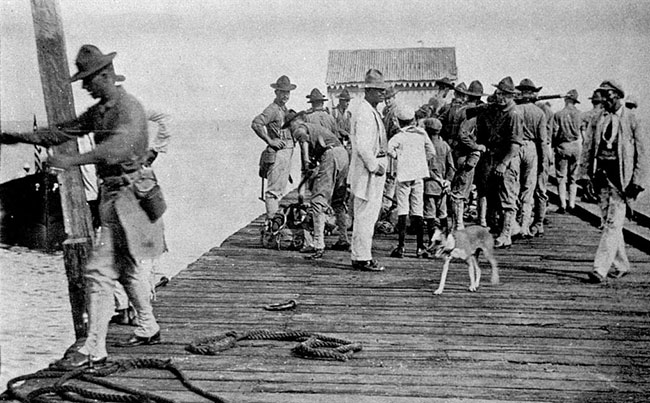
Ocupación militar del 1916 en República Dominicana by Walter. CC-BY-SA-3.0 via Wikimedia Commons.
It was one thing to subdue armed supporters of the regimes overthrown by the United States in all three countries. Latin Americans often met the demise of those unpopular governments with relief. Besides, armed groups recognized the overwhelming training and firepower of the marines and agreed readily to disarmament. As one Haitian palace guard recalled of the marine landing of 1915, “Everyone fled. Me too. You had only to see them, with their weaponry, their massive, menacing appearance, to understand both that they came to do harm to our country and that resistance was futile.”
It was the violence during “peace” time that turned the masses against occupation. At times marines and their native constabularies hunted small groups of insurgents and treated all locals as potential traitors. Other times they enforced new regulations, replaced local political officials, or militarized borders. And they could do it all with virtual impunity since any of their crimes would be tried by their own in US-run military provost courts.
Abuses were particularly frequent and grave either when no marines supervised constabularies or when a single marine — often a non-commissioned officer elevated to officer status in the constabulary — unleashed a reign of terror in a small town.
The residents of Borgne, in Haiti, for instance, hated a Lieutenant Kelly for approving beatings and imprisonments for trivial crimes or for no apparent reason at all. While in the Dominican Republic, around Hato Mayor, Captain Thad Taylor riled over his own fear-filled fiefdom. As one marine described it, Taylor “believed that all circumstances called for a campaign of frightfulness; he arrested indiscriminately upon suspicion; then people rotted in jail pending investigation or search for evidence.” In Nicaragua, the “M company” was widely accused of violence against children, especially throwing them into the air and spearing them with bayonets. In Haiti, a forced labor system known as the corvée saw Americans stop people, peasants, servants, or anyone else, in the street and make them work, particularly to build roads. The identification of the corvée with occupation abuse was so strong that, years later, Haitians gladly worked for foreign corporations but refused to build roads for them.
Rape added an element of gendered terror to abuses. The cases that appear in the historical record — many more likely went unreported — indicate an attitude of permissiveness, fed by the occupations’ monopoly of force, that bred widespread fear among occupied women. Assault was so dreaded that Haitian women stopped bathing in rivers.
Marines were none too careful about keeping abuses quiet and perhaps wanted them to be widely known so as to terrorize the populace. They repeatedly beat and hanged occupied peoples in town plazas, walked them down country roads with ropes around their necks, and ordered them to dig graves for others.
Brutality also marked the behavior of US troops in the cities, where there was no open rebellion. Often, marines and sailors grew bored and turned to narcotics, alcohol, and prostitution, vices that were sure to bring on trouble. A Navy captain suggested the humiliation suffered by Nicaraguan police, soldiers, and artisans, who all made less money than local prostitutes. He also noted the “racial feeling, . . . which leads to the assumption of an air of superiority on the part of the marines.” In response, the US minister requested that Nicaragua provide space for a canteen, dance hall, motion picture theatre, and other buildings to occupy the marines’ time.
Even the non-violent aspects of occupation were repressive. A French minister in Haiti noted that all Haitians resented intrusions in their daily freedoms, especially the curfew. Trigger-happy US soldiers on patrol also exhibited “an extraordinary lack of discipline and in certain cases, an incredible disdain for propriety.” Dominicans considered US citizens to be “hypocrites” because they drank so much abroad while living under prohibition at home. Reviewing such cases, a commanding officer assessed that 90 percent of his “troubles with the men” stemmed from alcohol. In a particularly terrifying incident, private Mike Brunski left his Port-au-Prince legation post at 6 a.m. and started shooting Haitians “apparently without provocation,” killing one and wounding others. He walked back to the legation “and continued his random firing from the balcony.” Medical examiners pronounced Brunski “sane but drunk.”
Abuse proved a recruiting bonanza for insurgents. Little useful information, and even less military advance, was gained from abuse and torture in Nicaragua. A Haitian group also admitted that “internal peace could not be preserved because the permanent and brutal violation of individual rights of Haitian citizens was a perpetual provocation to revolt.” Terror otherwise hardened the population against the occupation. Many in the Dominican Republic later testified with disgust to having seen lynchings with their own eyes. There and in Haiti, newspaper editors braved prison sentences to publish tales of atrocities.
By 1928, the State Department’s Sumner Welles observed that occupation “inevitably loses for the United States infinitely more, through the continental hostility which it provokes, through the fears and suspicions which it engenders, through the lasting resentment on the part of those who are personally injured by the occupying force, than it ever gains for the United States through the temporary enforcement of an artificial peace.”
Hostile, troublesome, horrifying: the US military in Latin America encountered a range of accusations as they it on believing that it brought security and prosperity to the region. Sound familiar? The lessons of Latin American resistance a century ago are especially relevant today, when counterinsurgency doctrine posits that a successful occupation, such as the one by coalition forces in Afghanistan, must win over local public opinion in order to bring lasting security. Thankfully, it appears that the lesson has sunk in to a certain extent, with diplomats increasingly reclaiming their role from the military as go-betweens with locals. Yet much of the damage has been done, and in the case of drones, no amount of diplomacy can assuage the feeling of terror felt throughout the countryside of Afghanistan and Pakistan when that ominous buzzing sound approaches overhead. It is, perhaps for better and certainly for worse, the new face of US military occupation.
Alan McPherson is a professor of international and area studies at the University of Oklahoma and the author of The Invaded: How Latin Americans and their Allies Fought and Ended US Occupations.
Subscribe to the OUPblog via email or RSS.
Subscribe to only American history articles on the OUPblog via email or RSS.
The post The trouble with military occupations: lessons from Latin America appeared first on OUPblog.
Blog: Geoffrey Philp's Blog (Login to Add to MyJacketFlap)
JacketFlap tags: Caribbean, Jamaica, Haiti, Geoffrey Philp, Mia Leonin, #NCAHM2014, Anjanette Delgado, MJ Fievre, Cuba, Add a tag
The Betsy Writer's Room presents a multilingual, multicultural Reading at The Betsy, Friday, June 27 at 6 p.m. in B Bar.
The Betsy hosts authors from various Hispanic and Caribbean countries in a multilingual reading in B Bar. The evening will be broken up into two readings:
Escribe Aqui will feature readings in Spanish with Hernan Vera Alvarez (Argentina), Pedro Medina Leon (Peru), Camilo Pino (Venezuela) and Jose Ignacio Valenzuela (Chile) at 6PM.
Write Here will follow, with readings in English by Anjanette Delgado (Cuba), MJ Fievre (Haiti), Mia Leonin (Cuba) and Geoffrey Philp (Jamaica).
Special Musical Performance by jazz saxophonist, Nestor Zurita.
Books & Books will have copies from selected works available for purchase.
CLICK HERE TO RESERVE YOUR SEAT NOW.<http://the-betsy-south-beach.ticketleap.com/betsy-write-here/details>
Cash bar available. This is a free event.
Blog: Tara Lazar (Login to Add to MyJacketFlap)
JacketFlap tags: Haiti, Books and Smiles for Haiti, Chieu Urban, Children, Children's Books, Add a tag
 by author Chieu Urban
by author Chieu Urban
Thank you Tara, for inviting me to spread awareness of Books and Smiles for Haiti to this talented group of authors, illustrators, agents, editors, and children’s book enthusiasts.
For the past few summers, I have shared my books with the children of Haiti, and the pictures and smiles and thankful notes I’ve received remind me of why I enjoy creating books for kids. I think that it would be fantastic if they were to receive even more books from our community.
Please join me in sharing your wonderful books for the sweet children of Haiti. Although their needs are much bigger, these gifts will bring smiles to their faces and joy to their day.
I am thankful to President Steven Mooser of The Society of Children’s Book Writers and Illustrators for kindly donating two boxes of books and jump starting the campaign! The amazing people of Life Connection Mission are dedicated to getting the books to the children. They are a non-profit organization serving the poorest children in the Western Hemisphere. A special thank you to the generous authors, illustrators, and children’s book community who have already contributed to this project.
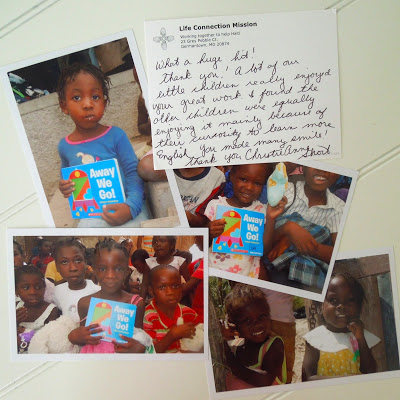
Photo courtesy of Life Connection Mission
We are collecting board books, picture books, beginning readers, and information books with pictures of animals, science, space, and more.
Our goal is to have a really great collection of books by the end of the school year, when they will be crated up and transported to Haiti. I am very excited about this project and look forward to partnering with our talented children’s book community.
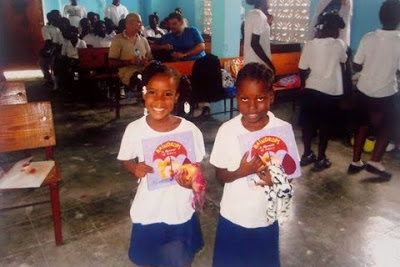
Photo courtesy of Life Connection Mission
If you would like to participate in Books and Smiles for Haiti, please email me at chieuurbanstudio (at) gmail (dot) com for the mailing address. Together, we will see our efforts grow. Please join our Facebook group page for updates.
Thank you, Chieu!
And now for the giveaway…
If you pledge to donate to Books and Smiles for Haiti, I will enter you into a drawing for a picture book critique from me, Tara Lazar. I will keep the comment thread open through the month of March. Just leave a comment stating you’ve donated in order to be eligible for the critique. And thank you for supporting this wonderful cause!
Blog: First Book (Login to Add to MyJacketFlap)
JacketFlap tags: books, Books & Reading, Book Recipients, First Book, Book Distributions, global, Caribbean, USAID, Kyle Zimmer, Haiti, First Book Partners, Jet Blue, Bel-Air, Ecole Herve Romain, Port Au Prince, Add a tag
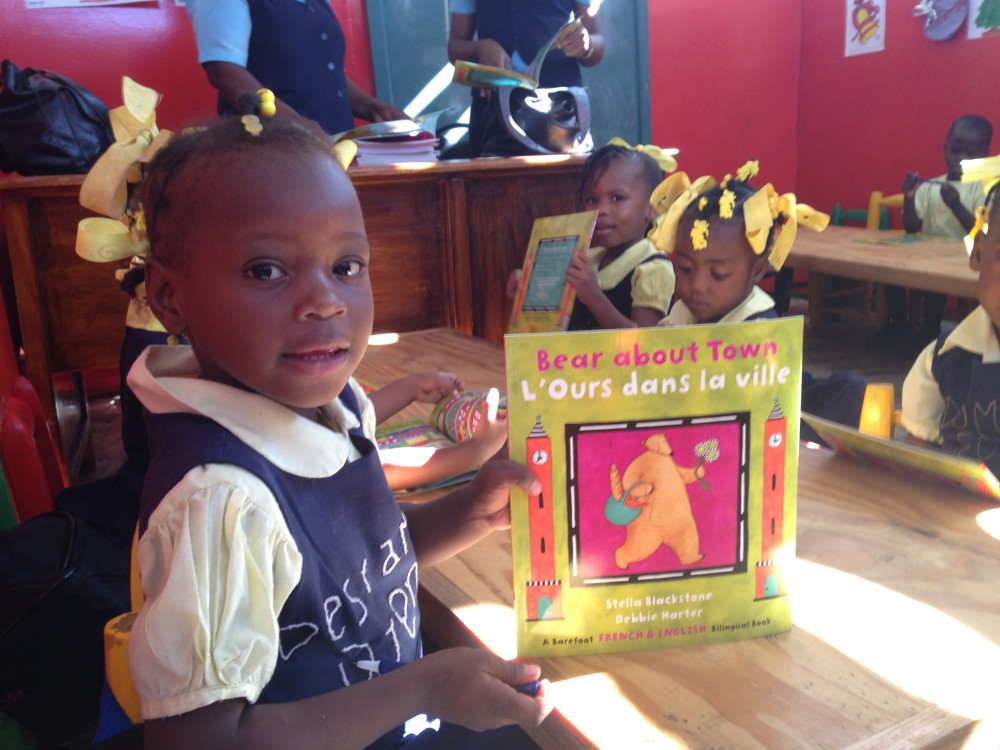 Four years ago this week, a magnitude 7.0 earthquake struck the Caribbean nation of Haiti. The tragedy left 1.5 million citizens displaced from their homes, hundreds of thousands dead and devastated an already depressed economy.
Four years ago this week, a magnitude 7.0 earthquake struck the Caribbean nation of Haiti. The tragedy left 1.5 million citizens displaced from their homes, hundreds of thousands dead and devastated an already depressed economy.
Today, Haiti remains the poorest country in the Americas. And while much has been done to aid Haiti’s recovery, a staggering eighty percent of the population lives below the poverty line.
Poverty keeps millions of children from accessing the world of knowledge that books provide. First Book is committed to changing that, by bringing badly-needed books and educational materials to children in countries like Haiti. Last month we had the opportunity to deliver books to kids in Haiti’s capital city of Port au Prince, a donation made possible through First Book’s longstanding partnership with Jet Blue.
At Ecole Herve Romain, a local school in the Port au Prince “red-zone” of Bel-Air known for high crime and extreme poverty, 250 students previously had to share 50 books between them. Now they have a library of 500 new titles to read and explore.
In addition to providing books, First Book staff met with representatives from USAID and other global and national NGOs in hopes of creating partnerships that lead to more educational resources for Haiti’s kids in need.
“We believe that one book can change the world,” said Kyle Zimmer, president and CEO of First Book. “But we also know that building relationships with partners in Haiti and around the globe will be critical in to achieving our goal of providing books and educational resources to 10 million children in need worldwide by 2016. We want to understand local needs and connect the dots so that kids in need all over the world can read, learn and rise out of poverty.”
The post In a Haitian School, 50 Books for 250 Students appeared first on First Book Blog.
Blog: (Login to Add to MyJacketFlap)
JacketFlap tags: SCBWI, children's book, Haiti, chieu anh urban, Away We Go!, Life Connection Mission, Add a tag
children's books for the lovely children in Haiti. The gift of books
will brighten their day, and let them know that we are thinking of them.
| Photo courtesy of Life Connection Mission |
I am collecting board books, pictures books, beginning readers, and
 |
| Photo courtesy of Life Connection Mission |
we will see our efforts grow. Please spread the word!
If you are unpublished and would like to donate new book(s),
the children will love it!
Thank you for your kindness. I look forward to hearing from you!
[email protected]
Blog: Welcome to my Tweendom (Login to Add to MyJacketFlap)
JacketFlap tags: Friendship, school, romance, bullies, Walker Books for Young Readers, Catholic school, Haiti, 2013, cross cultural relationships, Add a tag
I first read about this book over at Ms. Yingling's blog. Romance is always a bit of a tricky thing in that I tend to find them super girly or super sexy. Farrar has hit the mark with A Song for Bijou in that it offers a boy's point of view without going into the realm of YA.
Alex knows the moment he lays eyes on Bijou that she is something special. Time seems to slow down so that he notices every detail about her: from the way that she unwraps her straw at Peas 'n Pickles, to her stiff new uniform and the butterfly purple beads that end her braids. The girl is with motor mouth Mary Agnes and Alex can she that she's not able to get a word in edgewise. Alex asks his friend Nomura who the girl is, but he doesn't know either.
It doesn't take Alex too long to find out. Bijou goes to St. Catherine's along with Mary Agnes and Ira's sister Maricel, and the boys attend St. Christopher's which is the brother school. Alex cannot wait to get to know Bijou, which shouldn't be too hard as they have a school dance coming up.
There are, however, a couple of obstacles that Alex has to get around before he can see what the possibilities are with Bijou. First of, she is living with her Aunt and Uncle who are super strict about her hanging out with non-Haitians let alone with boys. Then there are Rocky and Trevor - two tough guys who seem to have some interest in Bijou as well. Lastly, there is the fact that Alex doesn't exactly know what to do in order to get Bijou to notice him! He's been stuck at an all boys school forever, and hasn't had practice talking to girls aside from his mom and his sister Dolly.
Mary Agnes starts to hatch some plans that will allow not only Alex and Bijou to get to know one another, but herself and Nomura as well. What follows is a story filled with age appropriate angst, first love, cultural clashes and misunderstandings. Farrar gifts readers with the bitter sweet dance of first crushes from both Alex and Bijou's points of view. Cultural and racial differences are not shied away from and Alex and Bijou must both face prejudice in their quest to get to know each other. A breath of fresh air!
Blog: Kid Lit Reviews (Login to Add to MyJacketFlap)
JacketFlap tags: Children's Books, rain, children's book reviews, earthquakes, floods, hurricanes, thunder, Haiti, cholera, Mike Blanc, Vanita Oelschlager, 4stars, vanita books, Port-au-Prince, St. Helene Children's Village, stroms, tent-sity, Add a tag
I Came From the Water Vanita Oelschlager, author Mike Blanc, illustrator 4 Stars ………………………………….. I Came from Water (subtitled), One Haitian Boy’s Incredible Tale of Survival, is a story based on true events, told from the viewpoint of a surviving child. Moses was an infant when floods destroyed his hometown killing many people, including his [...]![]()
Blog: Crazy Quilts (Login to Add to MyJacketFlap)
JacketFlap tags: book review, haiti, Nick Lake, Book Reviews, Add a tag
title: In Darkess
author: Nick Lake
date: Bloomsbury, January 2012
main character: Shorty
Nick Lake tells the story of Haiti by combining the stories of Toussaint L’Overture and Shorty. When we meet Shorty, he is trapped in a hospital that has collapsed on him in the 2010 earthquake that devastated the country. He uses his time in darkness to tell us about his life and why he was in the hospital. In his telling, we probably learn as much about Haiti as we do about Shorty because the gang violence and religious beliefs that are part of Shorty’s life are also very much part of Haiti. Perhaps only in a culture that believes in voodoo and Zombies could Toussaint and Shorty become one. Or do they? Is Lake artistically stating that Haiti’s past and present is linked in darkness?
Biggie stopped the car.
–Y’a pwoblem? he said.
–Gen pwoblem, said Manman. Not with you, anyway, Biggie. But that’s my son in your car. My kid.
Biggie laughed.
–I don’t see a kid, he said. I see a soldier. My frere chouchou. This kid’s one of my bodyguards. I love him, man. I love all my soldiers.
Manman looked at the gun in my hand. She said:
–Chita chouter yon your wap fait goal.
That’s something Manman used to say to me a lot. It means if you keep shooting, you’ll make a goal. It means, if you keep doing that, you’ll get what you’re aiming for. It means basically, stop doing that, or you’ll get what you deserve.
Usually I laughed when Manman said it; it’s such an old woman thing to say. But then I had a gun in my hand and she was talking about shooting and it made me uncomfortable.
Lake’s experience in Haiti helps him creatively recreate the textures of Haitian life. It is a story about a narrow part of Haiti but it is also a story that takes us to a small place in the world that readers wouldn’t otherwise know. In the Author’s Note, Lake tells us that the neighborhood in which the story is set is perhaps the most violent place on earth. He writes about its violence, bondage, pain and history and somehow in all this, he manages to provide a sliver of hope that the Haitians will indeed one day be free.
Filed under: Book Reviews Tagged: book review, haiti, Nick Lake
Blog: Donna Pellegata ~ ArtQwerks ~ Art Blog (Login to Add to MyJacketFlap)
JacketFlap tags: illustration Friday, teacher, childrens illustrator, ArtQwerks, Donna Pellegata, childrens art, Haiti, haitian children, Haitians, Add a tag
How Haitians Play Basketball
Blog: Donna Pellegata ~ ArtQwerks ~ Art Blog (Login to Add to MyJacketFlap)
JacketFlap tags: haitian children, illustration friday bounce, Haitians, childrens illustrator, ArtQwerks, Donna Pellegata, childrens art, Haiti, Add a tag
How Haitians Play Basketball
Blog: Beth Kephart Books (Login to Add to MyJacketFlap)
JacketFlap tags: Brother, Haiti, Edwidge Danticat, I'm Dying, Add a tag
Saturday night, a young woman I'll call E. returned from her year in Port-au-Prince, where she had been at work in a hospital clinic as a nutrition program coordinator. Daughter of remarkably loving parents, sister to an incredibly talented and goodhearted son, E. is also a member of my church family (she is as well a super-star athlete, but that's a tale for another day). We were all collectively holding our breath until E. arrived home safely. We knew how much good she was doing over there. We equally recognized that Haiti is not the easiest domicile for a recent college grad.
In honor of E.'s safe return home, I read Brother, I'm Dying, the Edwidge Danticat memoir. The book had been sitting here for quite some time. Having finished it this morning, I can neither understand nor forgive my earlier resistance to it.
For this is a book. This is memoir at its most pure and form-redeeming—intelligent, researched, heartfelt. Calmly and with great care, Danticat weaves together the story of the man who raised her as a child in Bel Air, Haiti (her uncle), and the man who fled to Brooklyn in an effort to create for his whole family a better life (her father). Two brothers, then, two father figures, and two ultimately tragic trajectories as each man fights to survive impossible odds and their daughter fights hard not to lose them. In a single year—2004—Danticat, now married, in Miami, pregnant with her daughter—will watch her world unravel. She will bear witness to what revolutionary upheaval and disease can do to the men who, for so much of her youth, were not just essential but invincible.
Memoirs that make room for family history and country politics challenge their writers structurally; they ask more from the words on the page. No false binding will do, no obvious superimpositions, no easy themes, no ready truths. There are higher stakes, in memoirs like these. More is expected, more wanted. Danticat, who has proven herself in book after book, forges a remarkable narrative. She is there throughout, of course; memoir by definition is an "I story. But she is not her memoir's heroine; she is its maker, and there's a difference. She has set out to honor others, not to claim pity for herself. She has written with both intimacy and something I can only call nobility. She has made of fragments a whole. We believe her, utterly, when she writes these words:
I write these things now, some as I witnessed them and today remember them, others from official documents, as well as the borrowed recollections of family members. But the gist of them was told to me over the years, in part by my uncle Joseph, in part by my father. Some were told offhand, quickly. Others, in greater detail. What I learned from my father and uncle, I learned out of sequence and in fragments. This is an attempt at cohesiveness, and at re-creating a few wondrous and terrible months when their lives and mine intersected in startling ways, forcing me to look forward and back at the same time. I am writing this only because they can't.I am writing this only because they can't. Those who dismiss memoir as a genre have not read Brother, I'm Dying.
Blog: OUPblog (Login to Add to MyJacketFlap)
JacketFlap tags: History, World, caribbean, This Day in History, haiti, domingo, *Featured, higher education, this day in world history, toussaint, haitian, proclamation, general clerveaux, haitian independence, henri christophe, jean-jacque dessalines, dessalines, 1803, designs—fueled, Add a tag
This Day in World History
November 29, 1803
Haitian leaders declare independence
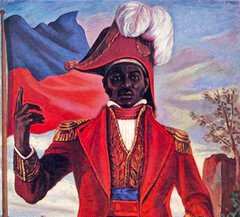 On November 29, 1803, Haitian leaders Jean-Jacques Dessalines, Henri Christophe, and a General Clerveaux joined together to sign a preliminary proclamation of independence for St. Domingo, the former French colony that soon after took the name Haiti. The proclamation came just ten days after French forces under the Vicomte de Rochambeau had surrendered to the Haitian rebels.
On November 29, 1803, Haitian leaders Jean-Jacques Dessalines, Henri Christophe, and a General Clerveaux joined together to sign a preliminary proclamation of independence for St. Domingo, the former French colony that soon after took the name Haiti. The proclamation came just ten days after French forces under the Vicomte de Rochambeau had surrendered to the Haitian rebels.
The Haitian revolt had been launched in 1798 by Toussaint Louverture, a former slave whose original goal had not been independence. By 1802, though, the Haitian rebels had grander designs—fueled in part by concerns that the French would restore slavery and spurred further by the death of Toussaint under French arrest. On November 19, 1803, they won a decisive victory over French forces at the Battle of Vertieres. Ten days later, at their headquarters at Fort Dauphin, the rebel leaders issued their proclamation of independence, given “in the name of the black people, and men of color of St. Domingo.” The proclamation went on, “Restored to our primitive dignity, we have asserted our rights; we swear never to yield them to any power on earth.” The secretary who recorded the document sent a copy to a Philadelphia newspaper, and it was published widely in the United States..
The Haitian leaders issued a more formal document, the Act of Independence, on January 1, 1804. In this act, the signers pledged their support to independence, explained the significance of the act, and named Dessalines leader of the new nation. At this time, the rebels adopted the name Haiti, derived from Hispaniola’s indigenous Taino people, as the name of their nation. Haiti became just the second independent nation in the Americas—and the first nation formed by a successful slave revolt.
“This Day in World History” is brought to you by USA Higher Education.
You can subscribe to these posts via RSS or receive them by email.
Blog: Book Dads (Login to Add to MyJacketFlap)
JacketFlap tags: teens, Book Review, short stories, ya lit, Adoption, 9/11, book dads, haiti, Nicole Weaver, Multicultural Lit, Third Through Sixth Grade (Age 9-12), Teens: Young Adult, My Birthday is September 11, Add a tag
 My Birthday is September 11 (And Other Short Stories) by Nicole Weaver
My Birthday is September 11 (And Other Short Stories) by Nicole Weaver
Review by Chris Singer
About the author:
Nicole Weaver was born in Port-au-Prince Haiti. She came to the United States when she was ten years old. She is fluent in Creole, French, Spanish and English. She is a veteran teacher of French and Spanish. She is the author of a children’s tri-lingual picture book titled “Marie and Her Friend the Sea Turtle.” The story is about a Haitian little girl who resided by the beach in Haiti. Her second trilingual children’s picture book will be published by Guardian Angel Publishing. The book titled, “My sister is my Best Friend ” will be published in 2011.
About the book:
Growing up is filled with new experiences and they partner emotions. Our trials in life teach us compassion and help us to empathize with others. Our difficulties make us who we are, helping each of us to find our place in the world.
In this collection of short stories, simple acts of kindness make a world of difference in the lives of individuals. The theme of compassion weaves through all five stories, inspiring readers to discover this important lesson in life; we were created to help others.
My take on the book:
This is a nice collection of stories which touches on topics from bi-racial adoption and bullying to overcoming the tragedies of 9/11 and natural disasters through giving and paying it forward.
While touching on these topics, this collection for middle and teen readers shares the common theme of being stories about children dealing with real life struggles, and how kindness and empathy can turn someone’s life around for the better.
Here’s a quick breakdown of the stories:
* “My Birthday is September Eleven” – The title story of the collection is about a boy who was born on 9/11/01 and finds it hard to celebrate his birthday because of the tragic events of that day.
* “Zebra Boy” – A bi-racial boy stands up to a bully because of the support from his best friend.
* “The Good Samaritan” – An anonymous donor contributes the money necessary to help a group of fifth-graders pay for a life-saving surgery for a classmate.
* “No More Hunger” – Ronald becomes impoverished after a devastating hurricane destroys his village in Haiti. Unable to survive on his own, he is rescued from certain death by a kind stranger.
* “A New Life” – A bi-racial boy finally escapes a difficult past when he is adopted by a caring couple.
The stories are well-written and can be useful for inspiring an excellent discussion between middle and teen readers and their parents and teachers.
As I read the stories, I kept thinking of Gandhi’s quote: “Be the change you wish to see in the world.” I think these stories hold that kind of potential for young readers. They may be inspired to make a positive difference in someone’s life by either contributing financially to a cause, showing empathy for others or even standing up beside someone being treated unjustly.
Blog: PaperTigers (Login to Add to MyJacketFlap)
JacketFlap tags: Picture Books, Haiti, Edwidge Danticat, Alix Delinois, Week-end Book Reviews, Week-end book review, Eight Days: A Story of Haiti, Add a tag
 Edwidge Danticat, illustrated by Alix Delinois,
Edwidge Danticat, illustrated by Alix Delinois,
Eight Days: A Story of Haiti
Orchard Books, 2010.
Ages 5-11
When a devastating earthquake struck Haiti in January 2010, Haiti-born author Edwidge Danticat struggled to find a way to help her daughters make sense of it. In her Author’s Note at the end of the book, she explains that she wrote Eight Days: A Story of Haiti as a response to her five-year-old daughter’s concerns: “I carefully told her about a few people, among them some children, who had been miraculously rescued.” The result is this story of a young boy who is rescued after being trapped for eight days, during which hope, luck and his memories and imagination all play a part in his survival.
The story begins with the boy’s rescue – the accompanying illustration of an apparently international press pack gets the point across that his survival is newsworthy. The questions asked will resonate with young readers: “Were you afraid? Were you sad? Did you cry?” The boy’s response forms the framework of the story, as he relates one activity/memory for each day. This device is the perfect vehicle to show how he and his friend Oscar used the power of their imaginations to separate themselves from the reality of their situation: but it also allows the blur between imagination and reality to come through in the narrative. So, for example, they spend Day 5 playing soccer with their friends. “Oscar felt really tired and went to sleep. He never woke up. That was the day I cried.” Or again, on Day 6, he is in the countryside playing with his sister and getting “soaking wet and muddy”, catching “a mouthful of rain”…
Illustrator Alix Delinois, who was also born in Haiti, brings the boy’s imaginings to life. His palette of almost overpoweringly bright colours conveys the hyper-reality of his memories of what are, after all, very real people and events. This interplay between the boy’s imagination and his physical situation allows Eight Days to be absorbed and pondered by young children at just that age when awareness of the human cost of natural disaster is dawning; and it also makes it a good book to read with older children. This is a book for sharing. It will raise plenty of questions, as well as perhaps the need for reassurance, and some searching of young readers’ own imaginations.
Marjorie Coughlan
October 2011
Blog: Book Dads (Login to Add to MyJacketFlap)
JacketFlap tags: earthquake, book dads, jesse joshua watson, haiti, Projects We Support, hope for haiti, Preschool Through Second Grade (Age 4-8), Third Through Sixth Grade (Age 9-12), Book Review, support, Add a tag
 Hope For Haiti by Jesse Joshua Watson
Hope For Haiti by Jesse Joshua Watson
Review by Chris Singer
About the author:
Jesse Joshua Watson is an award winning, NY Times Bestselling illustrator and author whose work includes Hope for Haiti, Chess Rumble, and the Hank Zipzer series.
Whether hammocking in Brazil, exploring in Hong Kong, dodging taxis in Russia, studying art in Europe, dancing in Jamaica, or raising kids in Port Townsend, Washington, Jesse connects with people. He loves both the differences and the similarities that are so colorfully displayed across our diverse world. Jesse’s passion and appreciation of people is voiced through his brush and on his canvas.
About the book:
The earth shook, and his whole neighborhood was gone. Now he and his mother are living in the soccer stadium, in a shelter made of tin and bedsheets, waiting in line for food and water. But even with so much sorrow all around, a soccer ball inspires a small but powerful link between a heartbroken country’s past and its hopes for the future. Jesse Joshua Watson has created an inspiring testament to the strength of the Haitian people and the promise of children.
My take on the book:
For me, I have no doubts as to why soccer is called ‘the beautiful game’. Not only is it a game which is simply beautiful to watch but, because it is the most popular game in the world and such an integral part of so many peoples lives, it often can be used as a metaphor for life.
I’ve experienced this in action. While visiting for several weeks in a rural village in Uganda, I would get approached and greeted on a pretty regular basis because I would often wear soccer jerseys. I would get asked “Which football team do you support?” or “Are you a supporter of Arsenal (or Manchester United or some other English Premier League team)?’ If I had a soccer ball with me, I drew even more attention and more people who almost immediately became friends. Just because of a game. It’s powerful when you really think about it.
In Jesse Joshua Watson’s book, soccer becomes an even bigger metaphor. In the wake of such a horrible disaster, soccer brings some normalcy back for the children. Soccer is a game they most likely played everyday. Even amongst their immense sadness, the power of play and of playing soccer can bring back memories of good times. The young boy in the story even dreams of playing for his beloved Haiti and of scoring a winning goal.
This is a book which can and should be used in schools to teach children not only about Haiti, but also about hope in the midsts of great and seemingly insurmountable adversity. Young readers will certainly be inspired by the boy in the story and a creative teacher will be able to find a host of interesting activities that can be tied in with this book. Teachers can also pair it with another fantastic book about the earthquake in Haiti: Eight Days (A Story of Haiti).
Hope for Haiti is a beautifully written and illust
Blog: Walking In Public (Login to Add to MyJacketFlap)
JacketFlap tags: children's books, book reviews, picture books, charity, pearson, jesse joshua watson, haiti, disaster relief, we give books, good for you, hope for haiti, haiti earthquake disaster, on my mind foundation, Add a tag
Do something good before jetting off this weekend – check out this beautifully-produced video from Pearson’s We Give Books and On My Mind Foundation. These two organizations paired up on a trip to Haiti to help schools affected by the earthquake disaster last year, and address the overwhelming illiteracy rate in that area. Now, We Give Books is providing 1,000 books to kids in Haiti, and you can find out more and help here.
The video features Jesse Joshua Watson, author/illustrator of the Putnam book Hope For Haiti, one of my favorite picture books we’ve published recently. Jesse’s artwork is brilliantly colored and perfectly suited to this uplifting story. It goes well beyond soccer and speaks straight to the heart of Haiti’s youngest generation. A must read – and I’m so glad that children in Haiti were able to experience it in their own language!
Filed under: book reviews, good for you, picture books Tagged: charity, children's books, disaster relief, haiti, haiti earthquake disaster, hope for haiti, jesse joshua watson, on my mind foundation, pearson, picture books, we give books
Blog: Amsco Extra! (Login to Add to MyJacketFlap)
JacketFlap tags: Music, Social Studies, Caribbean, World History, Haiti, Add a tag
As part of the ¡Si Cuba! arts festival, the Creole Choir of Cuba will perform at the Brooklyn Academy of Music in early June. As an avid fan and student of Cuban and Haitian music, I’m absolutely thrilled about this upcoming performance. As both an educator and advocate of integrating the arts and cultural history into the classroom, I can’t help making connections between the Creole Choir of Cuba and social studies topics such as slavery, colonialism, Latin American history, the Haitian Revolution, Christopher Columbus, the Tainos, or “The New World,” in general.
 To begin a class, unit, or project by playing the Creole Choir’s song “Kadja Boswa” opens up many points of historical inquiry that students could investigate to understand colonization and slavery in the Americas from multiple perspectives. After the song is over, you could ask the class, “Why is a modern musical group in the Spanish speaking country of Cuba singing a song in French Creole to honor a West African spirit (Kadja) and their ancestors from a country with an Arawak (Ayiti or Haiti) word for its name?”
To begin a class, unit, or project by playing the Creole Choir’s song “Kadja Boswa” opens up many points of historical inquiry that students could investigate to understand colonization and slavery in the Americas from multiple perspectives. After the song is over, you could ask the class, “Why is a modern musical group in the Spanish speaking country of Cuba singing a song in French Creole to honor a West African spirit (Kadja) and their ancestors from a country with an Arawak (Ayiti or Haiti) word for its name?”Blog: OUPblog (Login to Add to MyJacketFlap)
JacketFlap tags: Health, History, Science, Current Events, Latin America, outbreak, haiti, Cholera, Christopher Hamlin, *Featured, diarrhea, London School of Hygiene, University of Notre Dame, outbreaks, abjectness, diarrheal, rehydrants, Add a tag
By Christopher Hamlin
The recent Cholera outbreak in Haiti reminds us that this is not simply a disease of the distant and unsanitary past. The current outbreak is both unique and typical. Caused by a disease that has a long and devastating history, this Haiti outbreak has much in common with the outbreaks of the nineteenth century and twentieth century. History helps us keep in mind five key factors:
The Role of Media Coverage in our awareness of cholera: In our current age, as well as in the past, the combination of rapidity and deadliness has made cholera epidemics into media events. In fact, much of the tragedy of global diarrheal disease happens beyond the public gaze. Vibrio cholerae accounts for only a small fraction of global diarrhea deaths. The microbe is widely distributed around the world. Most cholera cases are mild, often they will be unnoticed. Unfortunately these, and particularly those many diarrhea deaths, have become part of our normal.
Epidemiological Monroe Doctrinism: In the months preceding the Haiti outbreak there were outbreaks in Pakistan (following floods) and in parts of Africa. Western hemisphere outbreaks are news because they seem to threaten the sanitary sanctity of the U.S. Some reporters ask outright whether cholera will come to us; others hint. But how serious a problem cholera is conceived to be usually depends more on where the outbreaks are than how many are affected.
“Withering Othering”: This is a phrase I used in the book to indicate the ease, which came to prominence in the nineteenth century, with which we use presumed sanitary status to group human populations. Cholera epidemics are occasions for magnifying distance between a clean “we” and a dirty “they.” Cholera is rightly associated with poor sanitation, along with the host of social, economic, political, and cultural factors that contribute to its spread. But often, blaming unsanitary conditions is an excuse to lose sight of that bigger story. Haiti has often served as default abjectness for the western hemisphere. When something bad happens, we shrug and say “Well, it is Haiti.” Cholera reinforces that abject ahistorical identity. I have taught a bit of Haitian history, am an admirer and minor collector of Haitian art, but certainly no expert. But the historian’s business is to explain both the perception of abjectness and the complicated antecedents of this cholera. Earthquake destruction is part of that latter story, but diarrheal disease was high in Haiti even before that. Haiti is a poor country, with a difficult political past. All this is coming to bear tragically in a large number of individual lives.
Pretense of Order: As an outside observer, most of the information I get is though press conference statements. In these, whatever has happened and however many have just died, is equalized as grey fact. Nothing ruffles bureaucratic prose, well organized web-sites, or well-dressed spokespersons. Effective response, it seems, requires emotional control, and, somehow, an overlooking of tragedy. This is not new – historians of epidemics will have often been struck by the disparity between the chaos of mass disease and the need to project that those in charge have things in hand — but I was shocked to see it happening. The cholera riots in Haiti too are wholly typical – people in cholera-stricken cities have rioted throughout the world both in the nineteenth and the twentieth centuries. Often, in various ways, the pretense of normal seems to be at the root of their anger.
Preparation and Distribution of Resources: Cholera’s status in
Blog: Young Adult (& Kid's) Books Central (Login to Add to MyJacketFlap)
JacketFlap tags: Reviews, Haiti, Danticat, Add a tag
Blog: Shellie Neumeier (Login to Add to MyJacketFlap)
JacketFlap tags: Haiti, Stuff, earthquake, Add a tag
 A year ago today, the world rocked. Shifted until a small chunk of a moderate island dissolved into dust and debris. A year ago today, Haiti experienced an earthquake measuring 7.0 Mw. Do you remember where you were when you first learned of the disaster it left? What were you doing when you heard about the missionaries who tried to rescue street orphans? How you felt when you learned over 230,000 people died that day?
A year ago today, the world rocked. Shifted until a small chunk of a moderate island dissolved into dust and debris. A year ago today, Haiti experienced an earthquake measuring 7.0 Mw. Do you remember where you were when you first learned of the disaster it left? What were you doing when you heard about the missionaries who tried to rescue street orphans? How you felt when you learned over 230,000 people died that day?
And now? Did you know a population the size of Austin, TX is still homeless? One year later. As I sit and write this I can’t help but feel a paradox between my New Year’s hope to shed my Christmas cookie jiggle and the thin frames of those who wander the streets of the tent villages peppering Haiti’s former cityscape. 
May God move among the Haitians in a powerful, redemptive, beautiful manner. May we catch a glimpse of His power in the compassion found in the rebuilding efforts. May we all play our part in their recovery. And thank you God for the safety of my family and the home that I have.
Blog: OUPblog (Login to Add to MyJacketFlap)
JacketFlap tags: Oxford, mexico, Geography, middle east, Featured, terrorism, atlas, muslim, Harm de Blij, power of place, Greece, Wall Street, place of the year, yemen, Arab, jersey shore, haiti, eyjafjallajokull, seaside heights, why geography matters, Add a tag
YEMEN
Why Yemen, you ask?
It’s a place that seems to be on the brink of collapse, and even as we prepared to make this announcement, Yemen again emerged as a home base for terrorist plots. The stakes are high and the future is unclear for Oxford’s 2010 Place of the Year.
According to geographer Harm de Blij, author of The Power of Place and Why Geography Matters, “In the modern world of terrorist cells and jihadist movements, Yemen’s weakness spells opportunity.” Regional conflicts like the Houthi rebellion in the north and revival of the southern secessionist movement diminish the power of the government. Terrorist bases now reside in the remote countryside, posing a familiar dilemma for the United States: Is shoring up the country’s army and police worth the risk of increasing Al Qaeda protection and loyalty? At the same time Yemen stands to be the poorest country in the Arab world, nearly depleted of its leading export, oil, while facing a water shortage experts say is heighten by the country’s addiction to qat, a mildly narcotic leaf.
Once a promising experiment in Muslim-Arab democracy, Western opinion now recognizes Yemen to have all the features of a failed state. Obscured by the attention of the political geography, is what de Blij calls “a Yemen that might have been.”
To hear more from de Blij on Place of the Year be sure to check in tomorrow!
Yemen at a glance:
Population: 22,858,000
Capital(s): Sana’
Government: Multiparty Republic
Ethnic Groups: Predominantly Arab
Languages: Arabic
Religions: Islam
Currency: Yemeni rial= 100 fils
Cash crops: coffee and cotton
President: Ali Abdullah Saleh
And now for the runners-up…
Greece
Haiti
Gulf Coast (of the United States)
the Eyjafjallajokull volcano
Mexico
Seaside Heights, NJ
California
Rio de Janeiro
Wall Street
The Gulf of Aden (“Pirate Alley”)
OUP Employee Votes:
“I’d go with Mexico. A fascinating failing state in which our stake couldn’t be greater, and compelling for all the reasons the other places mentioned might be interesting (or in crisis) individually–you have natural disaster (or the ongoing potential thereof), man-made disaster, social unrest, crime (and how), political chaos and corruption, etc. Whatever you do, don’t pick Seaside Heights, N.J., though I’ve nothing whatever against the place.” -Tim Bent, Executive Editor, Trade History
“Haiti—so we don’t forget the hundreds of thousands of people who lost their families and homes and way of life.” -Jessica Ryan, Copyediting Lead
“Eyjafjallajokull. It’s perfect in that it had a world-wide impact, or close to it; it was hard to pronounce; and it was the proverbial flash-in-the-pan issue.” -Niko Pfund, VP and Publisher
“You totally made up that v
View Next 23 Posts





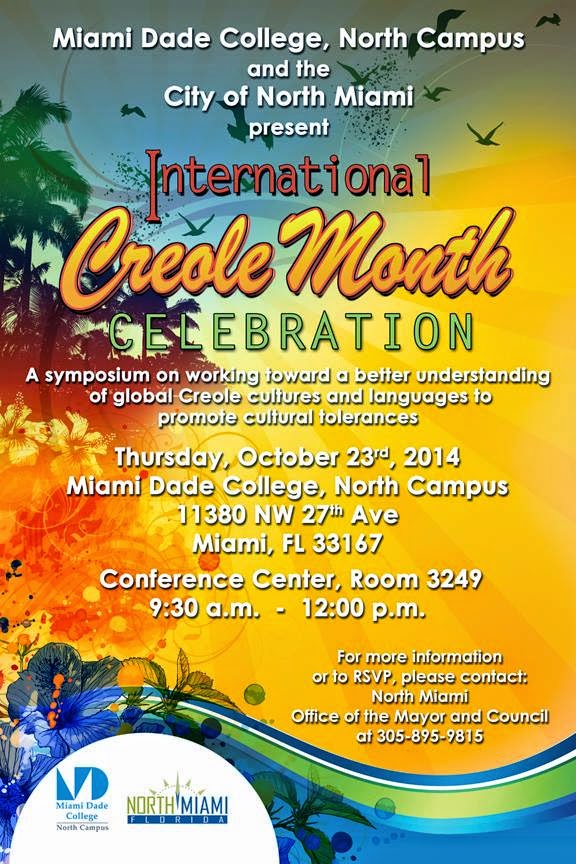









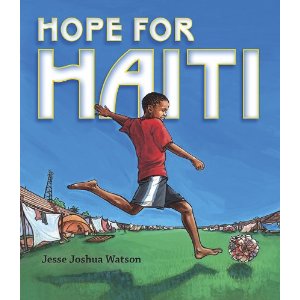

This was a great post. May is HAITIAN HERITAGE MONTH. This is wonderful that Chieu Urban is doing this. Good for her
What wonderful work you are doing, Chieu! Taking up space in my closet are author copies of my Rookie Read-About Geography books—7 books on the 7 continents. I have emailed Chieu about donating them.
Thank you, Chieu, and thank you Tara for helping to spread the word!
Tara…although there are many worthy organizations that are helping put books into the hands of kids, there aren’t enough – organizations OR books! Thanks for introducing us to BOOKS AND SMILES FOR HAITI and the dedicated Chieu Urban. I’d love to hop on board – and will be emailing Chieu right away to see how I can help.
I am always happy to donate to a good cause like this one. I’ve emailed Chieu with my donation.
Angela
I’m contacting Chieu next. I recently donated copies to the Pajama Program through Goodreads because I know the magic that happens when a child holds a picture book. Thank you for reminding us, Tara.
I’m always open to a challenge or a good cause, so count me in! I love helping young readers. I am more than happy to donate a picture book to Chieu for Books and Smiles for Haiti!
Getting books in the hands of children is a wonderful cause. My sister regularly volunteers as a nurse in Haiti and I’ve sent many basic items with her for kids and families. Now why on earth didn’t I think to send books? I’m in!
Thanks, Tara. Once I hear back from Ms. Urban, Blue Whale Press and I will be donating a box (24 brand new books) of BUTTERFLY KISSES FOR GRANDMA AND GRANDPA.
Count me in, this effort speaks to my soul.
What a great effort.